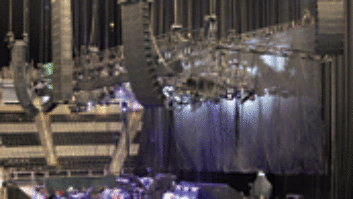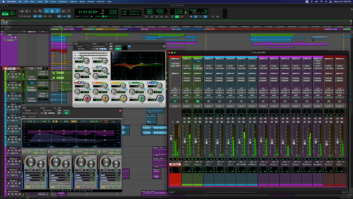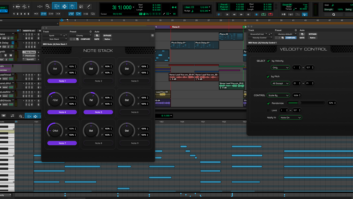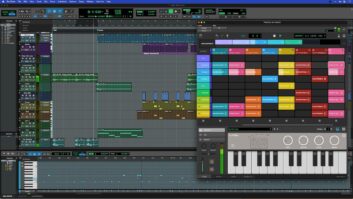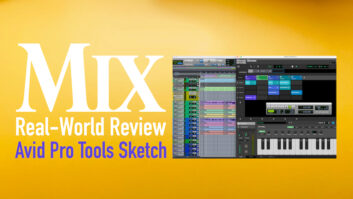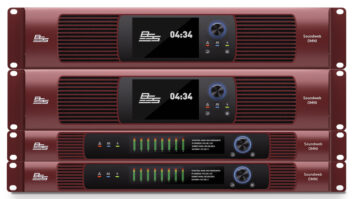Offering as many as 50 EQ filters, ten crossover types, output limiting and more than a second of alignment delay in a single-rackspace chassis, the BSS FDS-355 OmniDrive Compact’s arrangement of three inputs and five outputs is ideally suited for a wide variety of speaker processing applications. This can also be said of the new FDS-366 Compact Plus, which has even more features, including digital inputs, alignment assistant and an extra output.
SAFEGUARDING YOUR DATA
Everyone knows that each press of the parameter wheel advances menu selection from left to right, and holding the wheel in while turning it quickly scrolls in either direction. But pushing the parameter wheel in for a couple seconds returns you to the Default screen, which displays the current preset’s title and output curve, and makes a good “home” screen, as turning the wheel here has no effect on settings.
The 355’s multiple security levels can serve to protect settings while allowing access to different users: The individual lock flag on each preset helps prevent accidental overwrites. An OEM lock allows concealing and tamper proofing critical parameters for specific speakers. The Owner lock uses a second password to lock and hide further selected parameters, and a user’s Lock Out offers temporary security, as anyone familiar with an OmniDrive can unlock this mode. There’s also an option to lock extra, unused filters to prevent further EQ on individual input or output channels. Shorter passwords are helpful during tweaking and R&D, when they’ll be locked and unlocked repeatedly. Choosing unique passwords is important-however, be warned that it’s impossible to unlock a unit whose password has been forgotten or maliciously changed.
CHANGE IN THE WEATHER!
The 355 lacks the meteorology probe of its larger sibling, yet temperature data from an OmniDrive FDS-388 can be sent to the 355 via MIDI. Or, using the Delay Correction in the utilities menu, you can manually tweak temperature, which defaults to 20D C (68D F). Delay units can be entered in meters or feet, yet there is no provision for changing temperature settings to Fahrenheit, so add or subtract 5D C for each change of 9D F. A delay time set on a hot afternoon will become early as the temperature drops toward show time. Alternatively, you can add 1% to each delay time for every 10D F of temperature drop.
BACKUP AND SWAP
This useful function allows users to make incremental adjustments and quickly audition the result by comparison, saving time and keystrokes when tweaking presets. When enabled, the Store key saves the current parameters into a Backup buffer, and the Recall key makes either the edited version or the Backup version active. With Backup/Swap on, a normal Store or Recall is only performed from the utilities menu or while the Default screen is showing, where a final version can be stored.
THE MIDI LINK
In Master/Slave mode, two units can be connected as a stereo pair by joining the MIDI output of the master to the MIDI input of the slave. up to five-way mono crossovers can be designed with the 355, with a separate input for auxiliary-driven subwoofers, and you’ll still have a third input for frontfills, a second console or a pink-noise generator.
SOFTWARE FUN
When the 355 first powers up, the last number displayed (preceded by “A”) is the application software’s version. On versions 1.10 and later, a custom logo (in a two-color, 128×56 pixel GIF file format) can be loaded that displays whenever the Lock Out utility is on. The 355 is the first BSS product to use Flash memory, and its internal software can be updated to the latest Version 1.14 using the free 355 Software Loader from the BSS Web site (www.bss.co.uk/software/software.htm). A null modem cable (also sold as a Laplink cable) connects it to a Windows 3.x or 95 PC to transfer software updates.
The 355 can be controlled from a Win95 PC with Version 3 of BSS’s free Soundbench software, which can also control VariCurve and OmniDrive 388/380 devices via MIDI from the Compact OmniDrive. This offers the ability to program offline and archive complex systems, including the model 920 Slave and the 380 OmniDrive Install, which have no front-panel controls. And as with these other devices, the 355 can also be controlled as part of a MIDI loop from an FPC-900R VariCurve Remote equipped with Version 1.16 firmware and a larger EPROM.
